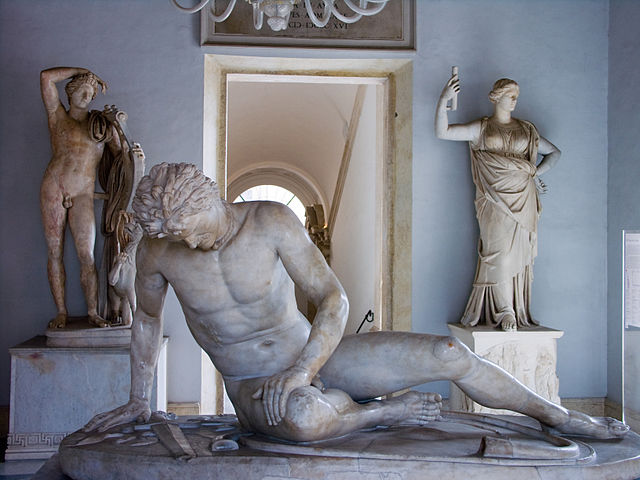Loading AI tools
Concept in classical sculpture From Wikipedia, the free encyclopedia
Heroic nudity or ideal nudity is a concept in classical scholarship to describe the un-realist use of nudity in classical sculpture to show figures who may be heroes, deities, or semi-divine beings. This convention began in Archaic and Classical Greece and continued in Hellenistic and Roman sculpture. The existence or place of the convention is the subject of scholarly argument.




In ancient Greek art, warriors on reliefs and painted vases were often shown as nude in combat, which was not in fact the Greek custom, and in other contexts. Idealized young men (but not women) were carved in kouros figures, and cult images in the temples of some male deities were nude. Later, portrait statues of the rich, including Roman imperial families, were given idealized nude bodies; by now this included women. The bodies were always young and athletic; old bodies are never seen. Pliny the Elder noted the introduction of the Greek style to Rome.
Agnolo Bronzino's painting Portrait of Andrea Doria as Neptune (c. 1530) and Michelangelo’s statue David (1501–1504) were Renaissance examples. The convention is occasionally also described in the modern era, such as Antonio Canova's statue of Napoleon as Mars the Peacemaker (1802–1806) or George Bellows' anti-lynching lithograph The Law Is Too Slow (1923).
Nudity was often thought to be an important aspect of Greek civilization and was frequent in places such as gymnasiums and when competing in games.[1] At least by the Imperial period of Rome, this concept operated for women as well as for men, with females being portrayed through Venus and other goddesses.[2]
Particularly in Roman examples like the Tivoli General or Delos "Pseudo-Athlete", this could lead to an odd juxtaposition of a hyper-realistic portrait bust in the Roman style (warts-and-all for the men, or with an elaborate hairstyle for the women) with an idealized god-like body in the Greek style. Male genitalia explicitly were not depicted as overly well-endowed to separate a noble and modest facade from the connotation in Greek culture that larger endowments belonged to more primal and barbaric characteristics.[3]
As a concept, it has been modified since its inception, with other types of nudity now recognized in classical sculpture—e.g., the "pathetic" ("of Pathos") nudity of brave but defeated barbarian enemies like the Dying Gaul.[4] Tonio Hölscher has rejected the concept entirely for Greek art of the 4th century BC and earlier. [citation needed]
Seamless Wikipedia browsing. On steroids.
Every time you click a link to Wikipedia, Wiktionary or Wikiquote in your browser's search results, it will show the modern Wikiwand interface.
Wikiwand extension is a five stars, simple, with minimum permission required to keep your browsing private, safe and transparent.